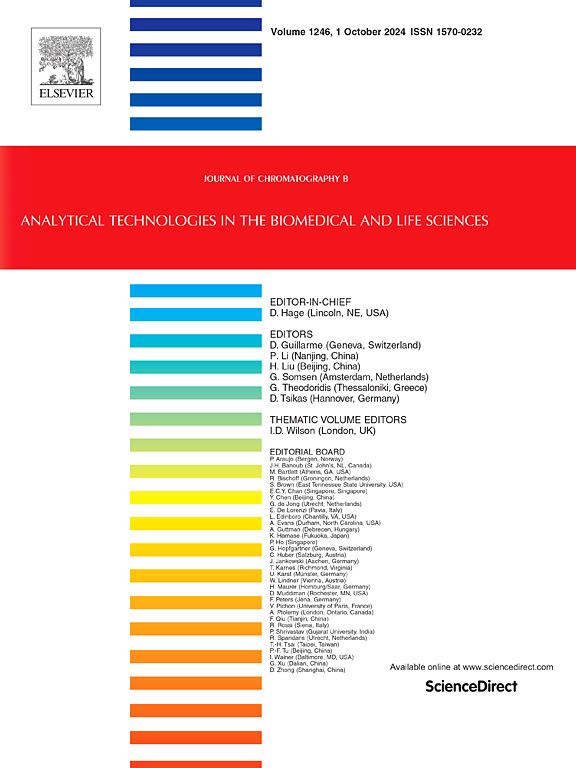自动免疫亲和液相色谱-串联质谱法定量测定人血浆中醛固酮
IF 2.8
3区 医学
Q2 BIOCHEMICAL RESEARCH METHODS
引用次数: 0
摘要
原发性醛固酮增多症(PA)的诊断依赖于醛固酮的准确测定。液相色谱-串联质谱法(LC-MS/MS)长期以来被认为是醛固酮定量的金标准,但它受到劳动密集型样品制备的阻碍。为了解决这个问题,我们在全自动设备上开发了一种免疫亲和-质谱(iMS)检测方法,将抗醛固酮抗体与稳定同位素标记的内标(IS)结合起来。该方法在15分钟内完成至少6个平行样品的平行制备,人工干预最少。主要性能指标包括定量下限(LOQ)为50 pg/mL,回收率为105.1 ~ 113.9%,线性范围为50 ~ 2000 pg/mL (R2 = 0.9993)。试验间变异系数(CV)为2.33% ~ 3.91%。血浆醛固酮浓度与免疫分析法具有较高的相关系数(R = 0.947)。总的来说,这种自动化的高通量平台提供了临床级的灵敏度、精度和可扩展性,使其适合常规测试,并适用于其他临床分析。本文章由计算机程序翻译,如有差异,请以英文原文为准。
An automated Immunoaffinity liquid chromatography-tandem mass spectrometry assay for quantification of aldosterone in human plasma
The diagnosis of primary aldosteronism (PA) relies on the accurate determination of aldosterone. Liquid chromatography-tandem mass spectrometry (LC-MS/MS) has long been considered the gold standard for aldosterone quantification but it is hindered by labor-intensive sample preparation. To address this, we developed an immunoaffinity-mass spectrometry (iMS) assay on a fully automated device combining anti-aldosterone antibodies with stable isotope-labeled internal standards (IS). This method completes sample preparation within 15 min for at least six parallel samples in parallel with minimal manual intervention.
The key performance metrics include a lower limit of quantitation (LOQ) of 50 pg/mL, recovery rates between 105.1 and 113.9 %, and linearity in the range of 50–2000 pg/mL (R2 = 0.9993). Inter-assay coefficient of variation (CV) ranged from 2.33 % to 3.91 %. In addition, plasma aldosterone concentrations by iMS and immunoassay had a high correlation coefficient (R = 0.947).
Overall, this automated high-throughput platform delivers clinical-grade sensitivity, precision, and scalability, making it suitable for routine testing and adaptable for other clinical analytes.
求助全文
通过发布文献求助,成功后即可免费获取论文全文。
去求助
来源期刊

Journal of Chromatography B
医学-分析化学
CiteScore
5.60
自引率
3.30%
发文量
306
审稿时长
44 days
期刊介绍:
The Journal of Chromatography B publishes papers on developments in separation science relevant to biology and biomedical research including both fundamental advances and applications. Analytical techniques which may be considered include the various facets of chromatography, electrophoresis and related methods, affinity and immunoaffinity-based methodologies, hyphenated and other multi-dimensional techniques, and microanalytical approaches. The journal also considers articles reporting developments in sample preparation, detection techniques including mass spectrometry, and data handling and analysis.
Developments related to preparative separations for the isolation and purification of components of biological systems may be published, including chromatographic and electrophoretic methods, affinity separations, field flow fractionation and other preparative approaches.
Applications to the analysis of biological systems and samples will be considered when the analytical science contains a significant element of novelty, e.g. a new approach to the separation of a compound, novel combination of analytical techniques, or significantly improved analytical performance.
 求助内容:
求助内容: 应助结果提醒方式:
应助结果提醒方式:


